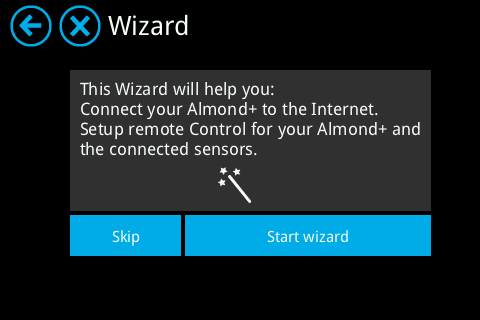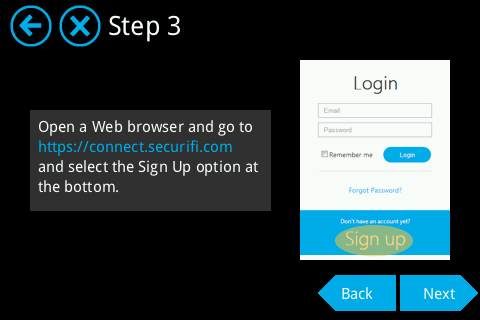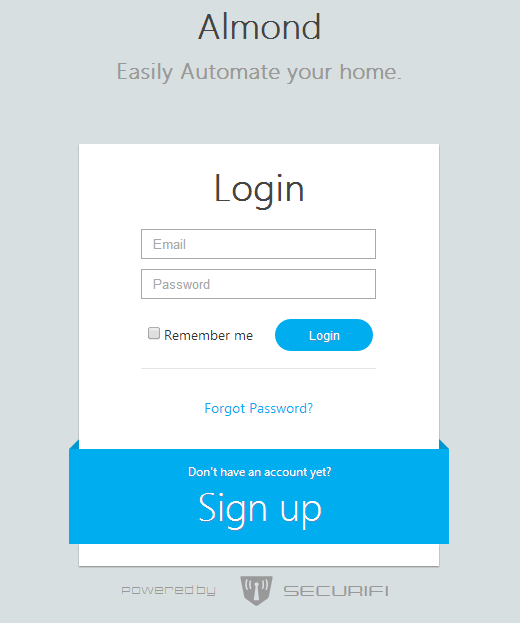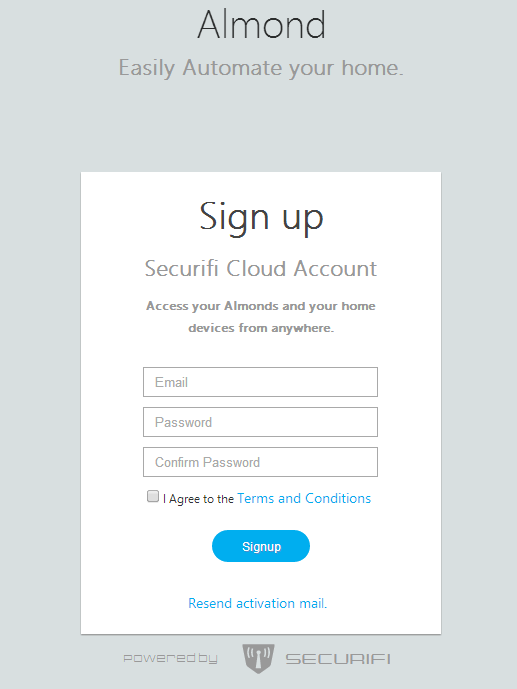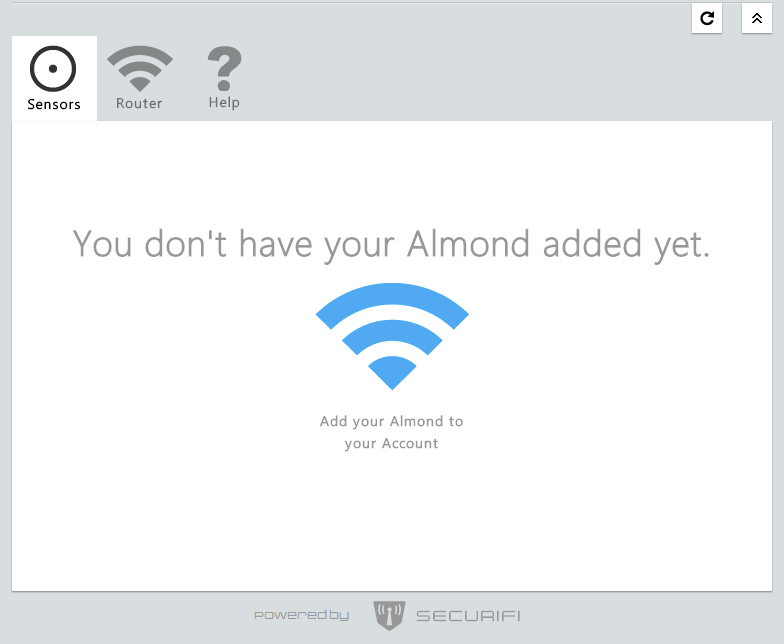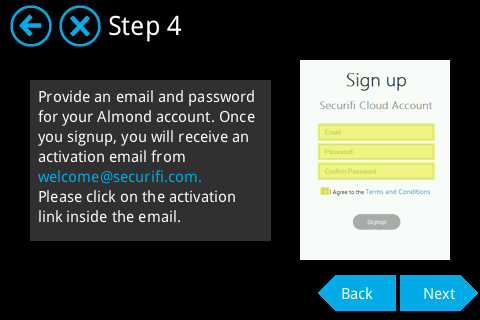Quick start guide - Almond+ 2014
This section will cover how to get your Beta/Developer unit up and running, including how to connect it to the Almond cloud service and how to add sensors etc. We'll expand this section as we add new features and over time this will be transitioned to separate sections in the Wiki. For the time being we're keeping everything on a single page to make it easier to find everything. This page will also contain the most up to date instructions.
Setup wizard
The first thing you’ll come across when you power on your Almond+ is the setup wizard. I’ll help you get connected to the internet.
Tap on [Start wizard] to get started.
This screen simply informs you of where you can locate your stylus on the Almond+.
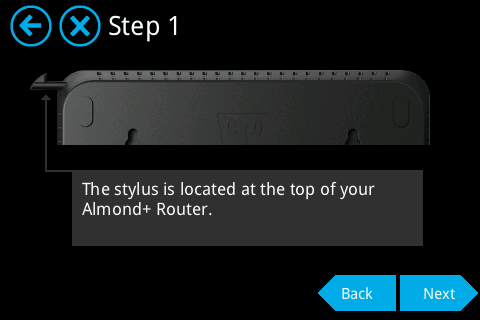
At this step you need to connect the cable from your internet connection to the Almond+. Depending on the type of Internet connection you have, you'll then be prompted on how to continue.
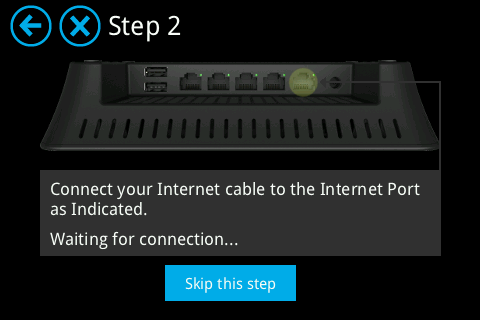
DHCP
If you're using DHCP, the Almond+ will auto detect your settings and you should simply see a dialogue asking you to wait for the connection to be verified, followed by a screen that informs you that you're connected to the Internet.

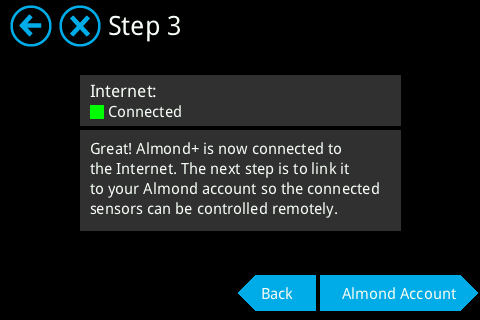
PPPoE
Cloud Affiliation
The next step involves connecting your Almond+ to the Almond cloud service for remote access to your sensors. Simply tap on [Connect to Cloud] at the end of the Setup wizard and you’ll be greeted by the following screen.
Note: In firmware R054, there's a bug that prevents the [Connect to Cloud] button from being tapped. As such, you'll have to finish the setup via the wizard and then locate the Cloud Affiliation app on the LCD UI and continue from there.
To connect your Almond+ with the Almond cloud service, you first need to set up an account. Please follow the steps described below to register for an account.
Open a web browser and go to https://connect.securifi.com/ and you should see the following screen. Please click on Sign up and proceed to the next step.
At this point, please enter your Email address and a password which you also need to confirm. Don’t forget to read and agree to the terms and conditions, then click on Signup.
The last step of the signup procedure is to active your account. You will be sent an email from welcome@securifi.com, so please make sure it hasn’t ended up in your spam filter/folder. Click on the link in the email and you should be ready to access the Almond cloud service.
Once you’ve logged in, you should see the following screen.
You’re now ready to continue the affiliation processor of your Almond+ with the Almond cloud service. Click on “Add your Almond to your Account” as per the picture above. This will take you to the Link Almond screen which is asking you to enter a code.
Tap on the Get Code button in the LCD UI of your Almond+ and you should get an auto generated code as per below. This code is case sensitive, unique and it’s a onetime only code which you have a two minute time limit to enter. If the time would run out, you can always get a new code and start over.
This code has to be entered into the code box as per the example below.
If the affiliation process was successful, you should see the messages below.
If the affiliation failed for some reason, you’ll see the following message.
After a successful affiliation, click on Done and you should see the following screen in your web browser.
To finalize the setup on your Almond+, simply tap on Finish and you’ll exit the wizard and enter the main LCD UI of your Almond+.
Associate Sensors
It’s now time to start adding sensors to your Almond+. To do this, tap on the Device Join icon on the LCD UI.
From here you can start adding your sensors. Simply tap on the Associate button.
At this point, you need to start the association process of your sensor or device. Please read the instructions that came with your sensor or device on how to add them to a network. There’s usually a button that should be pressed once to start the association process.
Once the sensor or device has been detect by the Almond+, you can change the default name and location by tapping in either text box. A virtual keyboard will appear and you can change it to something that makes it easy to locate. This can also be changed later. When finished, tap on Done!
Remove a sensor If for some reason you want to remove a sensor or device, simply tap on the Remove button and then follow the sensor or device manufacturer’s instructions on how to remove a sensors. This usually involves either pressing the button on the sensor or devices shortly, or holding it pressed down for about 10 seconds.
Additionally you can reset your Almond+ by selecting Reset. Warning: Doing this will forcefully remove all connected sensors and it’s not recommended to do during normal operation and should only be used to after you’ve manually removed all your sensors and device to purge any potential residual sensor data.
Controlling your sensors and devices Although the best way to keep an eye on all your sensors and devices are via the Almond cloud service (or the upcoming offline option), it’s possible to control and monitor your sensors and devices directly from the Almond+ LCD UI via the Connected Home app. Start it by tapping on the corresponding icon on the LCD UI.
In this example we have a binary power switch and a door/window sensor connected to the Almond+. Note: This is not the final UI for the Connected Home app.
The binary switch can be switched on or off from the LCD UI and some models with power metering functionality will also display it here.
The door/window sensor on the other hand simply displays a true/false statement, although this will show as open/close using the mobile or web apps.
Below is an example of the controls of a more complex device, in this case a Radio Thermostat.
